I woke up early (6:00) the next day. I was ready to go out and see some great birds, right in my neighborhood. Because this was a completely different habitat, I could hope to lifers in a suburban area. Our street wasn't called Cedarwood for nothing: it was surrounded by evergreen forest.
The first bird I heard that day were the STELLER'S JAYS. Their raucous calls started soon after I woke up. Knowing that the action was about to start, I leaped out of bed, took my camera and binoculars, dressed up warmly, and stepped out onto the porch. The second bird I heard was a calling AMERICAN ROBIN. Next, as I paced on the porch, watching the sun rise through the trees and breathing in the fresh mountain air, I heard a nasal, honking sound echoing through the forest: yank, yank, yank! Because I had listened to its call on the Cornell Ornithology website, I knew immediately that this was a RED-BREASTED NUTHATCH -- a yearbird, and a major target that I was pretty sure I would get. However, I wouldn't count the nuthatch until the next day, because I don't count heard only yearbirds or lifers.
As I hurried onto the street to walk around the street, the forest was coming alive with bird calls that sounded like MOUNTAIN CHICKADEES' and NORTHERN FLICKERS'. I saw many of the small birds cavorting around in trees, and knew they were Mountain Chickadees, but wouldn't count them until I got a satisfactory look at their heads, with the white eyebrow, making it my first yearbird of the day. I soon saw many flickers in the pines, eating the seeds in the pinecones, as well as many more Steller's Jays, and hearing lots of chickadees and nuthatches. Birding in this pine forest was difficult, as it was around freezing temperature (cold for a Californian), and uncomfortable clutching my binoculars in gloves, standing with a craned, hurting neck, staring up at the treetops through many branches trying to get a closer look at tiny birds 200 feet up. There, I said it. Whew!
I roamed around the neighborhood, watching the flickers eating on the pinecones -- the only easy-to-see birds here, along with DARK-EYED JUNCOS and Steller's Jays. As I focused my binoculars on a particularly big flicker, I noticed that it seemed much larger, longer beaked, not spotted on the breast, and with black wings. CLARK'S NUTCRACKER! This was another target bird, but one I wasn't so sure I would get, and my first lifer of the day. As I headed back home, I decided to take a shortcut through some brush, and heard a thin, high bird song. I had a hunch about what it was, but followed the song, which led me to my lifer GOLDEN-CROWNED KINGLET! I was feeling pretty good about my day so far as I walked into the house: two lifers and a FOY. Here's the eBird checklist for that morning:
http://ebird.org/ebird/view/checklist?subID=S15767713#share-checklist
We then decided to go on a hike to Mt. Judah, very near Donner Lake, which we visited yesterday evening. Most of us would go fishing at the lake, but I, my mom, and several of our friends would try to climb about 1000 feet up to a peak 8000 feet above sea level in cold weather on a snowed-over, but marked (with footprints), trail. Crazy, right?
As soon as we parked, I leaped out of the car and rushed toward the trailhead. While I was walking, I heard a high, thin birdcall, and turned to see a BROWN CREEPER land on a tree not more than five feet from me! This was by far the closest I had ever seen one, and was thrilled by having one of my favorite birds be so close to me. When we set off, the trail wasn't snowed over completely yet, but after a
mile or so, our only guides became the footsteps of other people. Here are some shots below:
 |
| View from the Mt. Judah Trail |
 |
| Castle Peak and surroundings |
 |
| Mary's Lake and Mt. Lincoln |
|
|
|
At one point on the trail, my mom heard a knocking sound and alerted me to it. We all stood still for some five minutes, and managed to find the woodpecker up about 50 feet in a tree. I knew it must either be a Hairy Woodpecker or a rarer Williamson's Sapsucker judging by the size, but I had forgotten their facial patterns, and not taken my Western Sibley, thinking all the IDs would be easy. My mom and I snapped several shots of the bird, and upon examination at home with a field guide, it was clearly a HAIRY WOODPECKER. Here is the "clincher" shot:
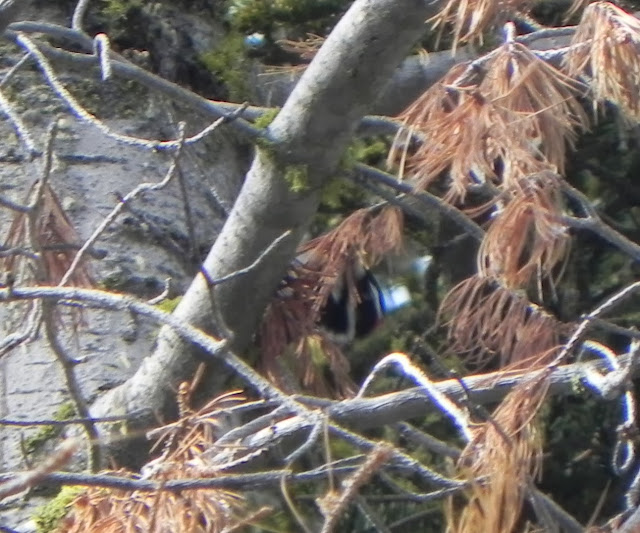 |
| Hairy Woodpecker |
|
|
The going was not easy, and we eventually came to a point on the trail where all the footsteps disappeared, leaving just a snowy forest floor. We decided to climb the nearby Donner Peak instead, named for the unfortunate Donner Party that got snowed in near this area in 1864, while traveling to California. The peak was accessible by a scramble from the trail to Mt. Judah, and we climbed to the top of the 8004 mountain. Here are some views from along the way:
 |
| On the way up Donner Peak |
 |
| Castle Peak and dead snag |
 |
| Donner Lake |
 |
| Mt. Judah (where we intended to go) |
 |
| Mt. Judah Trail and Mt. Lincoln |
|
Near the end of the hike, I heard a loud grating sound that I knew was a CLARK'S NUTCRACKER, mainly because of the beginning of the movie The Big Year. I managed to reel of some bad (amazing for me) shots of the birds. An interesting fact about them is that they can hide almost 100, 000 pine seeds for the winter, remembering where some are to to later eat them.
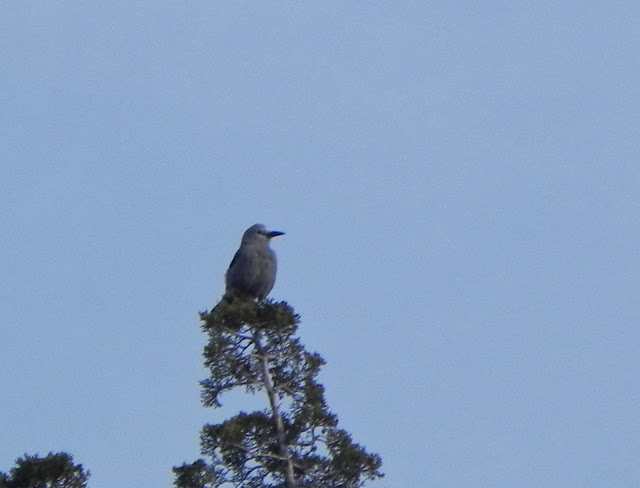 |
| Clark's Nutcracker |
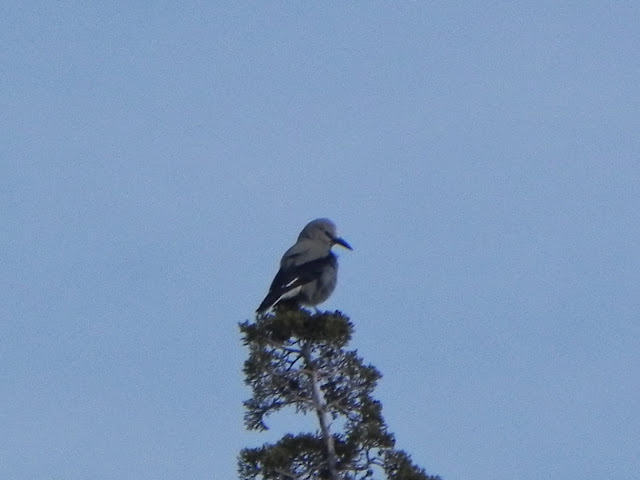 |
| Clark's Nutcracker |
More views, and a photogenic AMERICAN ROBIN:
 |
| Mt. Judah Trail view |
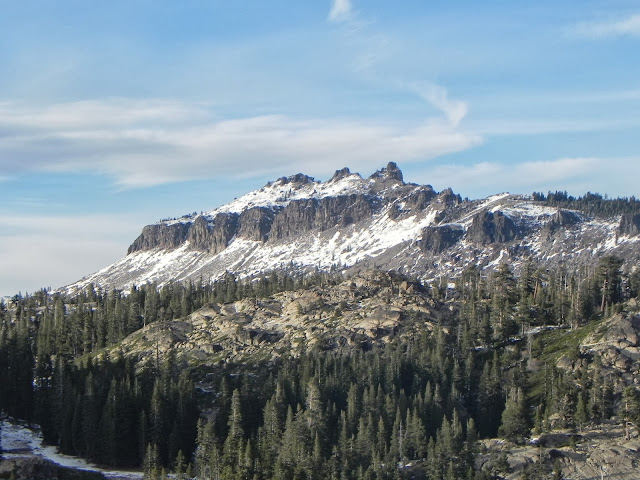 |
| Castle Peak (9001 ft) |
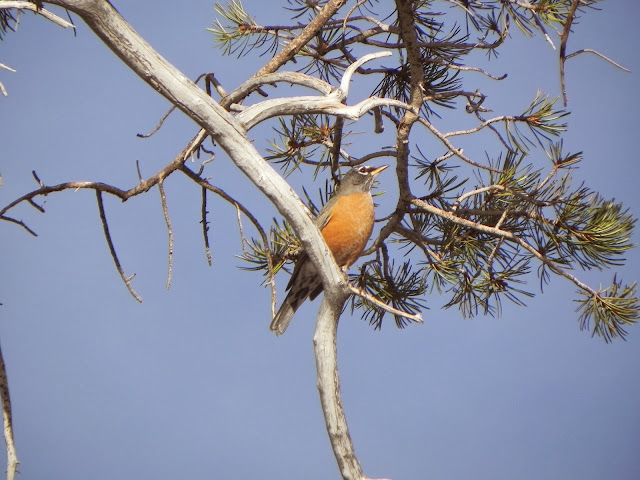 |
| American Robin |
 |
| American Robin |
Here's the eBird checklist for the Mt. Judah Trail:
http://ebird.org/ebird/view/checklist?subID=S15772164. That's all for the first day. Overall, I got one FOY (Mountain Chickadee) and two lifers (Clark's Nutcracker, Golden-crowned Kinglet). I learned that the birds are most active in our neighborhood from about 7:00 to 9:30, and that at earlier times it's too cold to go out, and all the birds have not woken up yet, and was ready to go see some more good birds tomorrow morning.
Good birding,
Sergey